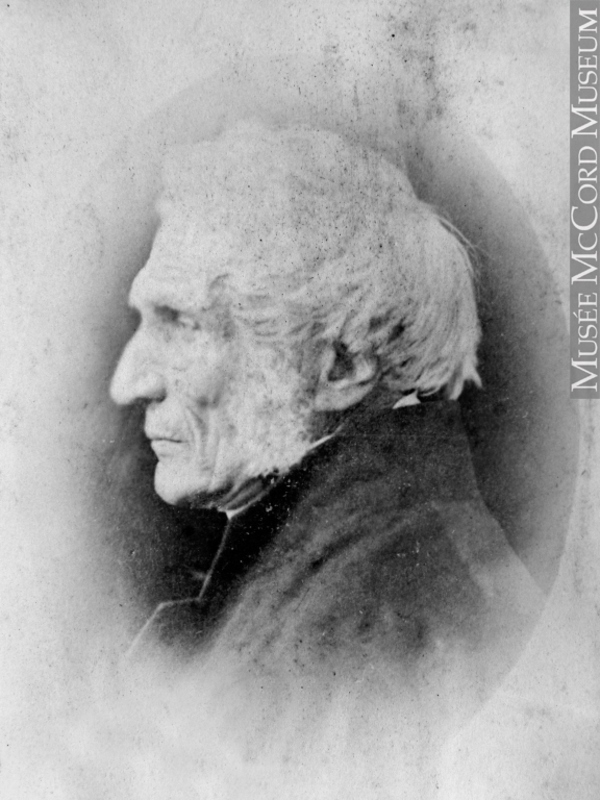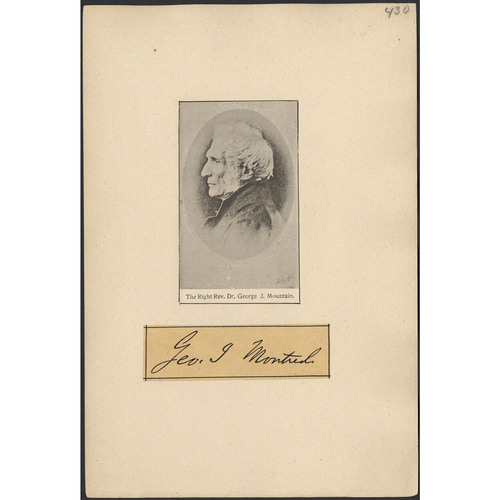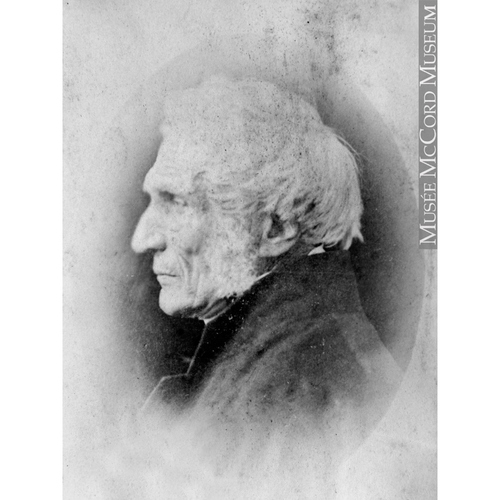
Source: Link
MOUNTAIN, GEORGE JEHOSHAPHAT, Church of England clergyman and bishop; b. 27 July 1789 in Norwich, England, son of Jacob Mountain* and Elizabeth Mildred Wale Kentish; d. 6 Jan. 1863 at Quebec.
The arrival of the Mountain family in Quebec City on 1 Nov. 1793 marked an important step in the establishment and development of the Church of England in Canada. George Mountain’s father, Jacob, had come as the first bishop of the diocese of Quebec; his uncle, Jehosaphat Mountain*, and his cousin, Salter Jehoshaphat Mountain, both became priests of the diocese; and George himself would become the third bishop. He was the first bishop of Quebec to grow up in Canada and the impressions of his youth created in him a deep and abiding love for the new country to which he was destined to devote himself.
George Mountain’s early education was provided by a private tutor, the Reverend Matthew Fielde, under whose guidance he displayed an aptitude for literature and exhibited an enthusiasm for poetry which was maintained throughout his life. He himself published a volume of verse in 1846 entitled Songs of the wilderness, a collection interesting for what it reveals of the character and personality of its author, but far from memorable from a literary standpoint.
In 1805 George Mountain and his older brother Jacob returned to England to complete their education. The Reverend T. Monro of Little Easton, Essex, had charge of the boys until they went to Trinity College, Cambridge, from which George obtained his bachelor’s degree without honours in 1810. His failure to win a fellowship at Downing College, Cambridge, led in 1811 to his return to Quebec. Always of a religious turn of mind, he had been confirmed by his father on 18 Sept. 1803, and on his return home, his decision to enter the priesthood firmly made, he placed himself as a student under the bishop’s tutelage. Acting as his father’s secretary he greatly relieved the heavy pressures upon him, and following his ordination as deacon on 2 Aug. 1812 in the Cathedral of the Holy Trinity he was appointed to assist Salter Jehoshaphat Mountain, the priest in charge of the cathedral. His diaconate coincided with the War of 1812 and in addition to his normal responsibilities the young clergyman volunteered for sentry duty on the walls of Quebec City.
In 1813 Mountain accompanied his father on his triennial visitation of the diocese and when they returned to Quebec the bishop considered his son sufficiently prepared for ordination. On 16 Jan. 1814 he was admitted to priest’s orders, and until August of that year he served as “Evening Lecturer” at the cathedral in Quebec. On 2 August, George Mountain married Mary Hume Thomson of Quebec City and the couple departed to take up residence in the parish of Fredericton, New Brunswick.
During their three years in Fredericton the Mountains won the undying affection of the parishioners. Probably the most lasting of their contributions was the establishment of a local branch of the Society for Promoting Christian Knowledge, through which the foundations of an educational system were laid. In addition to his parish work Mountain also successfully undertook the posts of chaplain to the legislature and to the military forces.
George Mountain’s return to Quebec in 1817 as officiating clergyman at the cathedral initiated a new phase of his career. His designation as “Official” of Lower Canada in 1818 was followed in 1819 by his receiving the degree of doctor of divinity from the archbishop of Canterbury and his appointment as a member of the Royal Institution for the Advancement of Learning. In January 1821 two archdeaconries were established in Upper and Lower Canada: George Mountain was created first archdeacon of Quebec and George Okill Stuart, archdeacon of York (Toronto). Later in the same year the parish of Quebec was erected by letters patent and Mountain was made the first rector.
Over a short span of time Mountain had attained a position of seniority among the clergy of Upper and Lower Canada, and in the last years of his father’s episcopate and for the entire period of Bishop Charles James Stewart*’s tenure (1826–36) he served the diocese as if he were already a consecrated assistant. It was not surprising then that on 14 Feb. 1836 he was consecrated at Lambeth Palace, London, as suffragan bishop in the diocese of Quebec under the title of bishop of Montreal, and that upon Bishop Stewart’s departure for England the same year he assumed full diocesan responsibility. In 1837 he formally succeeded Stewart as bishop of Quebec, but he continued to use the title bishop of Montreal until 1850, when a diocese of Montreal was created. When Mountain became bishop, Quebec Diocese extended from the New Brunswick border to the westernmost reaches of Upper Canada. Beyond Upper Canada the territory was legally under the authority of the bishop of London, but for practical purposes the diocese of Quebec extended virtually to the west coast. According to an estimate prepared by Mountain for Lord Durham [Lambton*]’s Report in 1838, his clergy numbered 117, with 73 in Upper Canada and 44 in Lower Canada.
As bishop, Mountain was faced with the task of creating a sense of diocesan unity in a country where communication was a major problem. In view of the hardships involved, it is one of his most remarkable achievements that throughout his career he methodically and indefatigably toured his diocese injecting new spiritual life into his people. He had begun this journeying as an archdeacon, his most notable excursions being to the Gaspé coast in 1824 and 1826. Transportation was always largely a matter of chance and on the 1824 expedition Mountain walked 25 miles across the peninsula through unbroken forest in the company of Indian guides. On all his tours the living conditions of the people and the state of religion and education in every settlement at which he stopped were his prime concerns, but undoubtedly the most memorable of his journeys was his 1844 expedition to the Red River, the first such visit by an Anglican bishop [see John Smithurst]. A handful of missionaries had been working there since 1820 and Mountain, after travelling nearly 2,000 miles largely by canoe or on foot, met with a warm reception from the mainly Indian and Métis population. His 18-day stay was an inspiration to the settlement but, more important, it was his plea that these people required greater assistance which stimulated the creation of the diocese of Rupert’s Land in 1849 with David Anderson* as first bishop.
Gradually the original see of Quebec was subdivided: in 1839 the diocese of Toronto had been established with John Strachan as bishop, and in 1850 Francis Fulford became the first bishop of the see of Montreal. In the later years of his episcopate no ventures show Mountain in a more courageous light than do his voyages to the Îles-de-la-Madeleine in 1850 and the Labrador coast in 1861. On the islands he discovered settlements which no non-Roman Catholic clergyman had ever before visited, and on the Labrador coast he met with a level of poverty for which all his years of experience had failed to prepare him. Just two years after his Labrador visitation, as he lay dying, Mountain’s thoughts dwelt on the problems of that struggling mission and his final word before blessing his children was “Labrador.”
One of George Mountain’s life-long interests was the promotion of education in the Canadas. Upon his return to Quebec in 1817 he had formed a Quebec diocesan committee of the SPCK, and with its support he turned to the establishment of a system of “National Schools” for the purpose of educating at no cost to the parents those children who could not meet the academic or financial requirements of the already functioning Royal Grammar Schools, sponsored by the British government. The original National School in Quebec City opened in 1819, and here the Bell system of instruction was employed whereby older children acted as monitors to teach the younger students. In April 1823 the SPCK committee established the Quebec Sunday School for those children unable to attend regular weekday classes.
Mountain’s influence is also to be traced in the histories of both McGill and Bishop’s universities. Letters patent incorporating McGill College were issued on 31 March 1821 and an honorary teaching staff was appointed in 1824, Mountain being named principal of the college and professor of divinity, both of which positions he held until July 1835. Under Mountain’s guidance McGill became an established, degree-granting corporation; nor did his resignation from the faculty terminate his relationship with the university. On Bishop Stewart’s death in 1837 he succeeded to the presidency of the Royal Institution for the Advancement of Learning which had received in 1813 the estate of James McGill* in trust for the endowment of a college or a university. In that capacity he became locked in a bitter controversy with John Bethune*, the acting principal of McGill, whose policy of developing the university as an Anglican stronghold was alienating many of its supporters. Bishop Mountain would not accept a seat on the Board of Governors of McGill unless Bethune were removed from his post, and in 1846 the principal was ousted by the British government.
George Mountain’s involvement with Bishop’s University was of a more personal nature for it was his desire to obtain new clergy for his expanding diocese which mainly stimulated the erection of the Anglican sponsored college in the Eastern Townships village of Lennoxville. Its foundation and growth became something of a favoured project for Mountain and was by his own admission amongst the most personally satisfying of his accomplishments. The parish of Lennoxville offered generous financial assistance to see a university established in the neighbourhood [see Lucius Doolittle] and royal assent was granted on 9 Dec. 1843. For its first ten years Bishop’s functioned without the essential power of being able to grant degrees, and both Mountain and the first principal of Bishop’s College, Jasper Hume Nicolls*, Mountain’s nephew and son-in-law, worked ceaselessly to obtain a royal charter. Finally, under continued pressure, the Canadian government relaxed its opposition and a charter was granted on 28 Jan. 1853 creating Bishop’s a university with the right to grant degrees in divinity, law, and medicine. Bishop Mountain’s dream was realized, and at the same time of his jubilee celebration in 1862 a scholarship in his honour was established at the university.
It was during Mountain’s episcopate that church government became an increasingly important issue and he was instrumental in laying the foundations for the system which is still functioning. The perplexing problem of financing his diocese made this development necessary. In the face of decreasing government support he organized in 1842 the Church Society of the Diocese of Quebec. It was designed, through a system of voluntary self-support, to assume the responsibilities for the salaries of missionaries and the building of new churches, but it also served as a stepping-stone to the creation of a diocesan synod. As the desire among the laity for responsible church government grew, Mountain initiated a correspondence with the other British North American bishops and under his auspices a conference was held at Quebec from 24 Sept. to 1 Oct. 1851 following which a plan for the erection of both diocesan and provincial synods was submitted to the archbishop of Canterbury.
In 1853 Mountain chaired a convention of colonial bishops in London, England, whose purpose was to legalize synodical government in all the colonies. The Colonial Church Bill failed to pass the British Parliament but eventually on 28 May 1857 an enabling act was passed by the legislature of the Province of Canada. Opposition from the evangelical part of the Anglican population, which sought to limit the power of the bishop for the advantage of the laity, forced delays and legal negotiations but Mountain was finally able to conduct his first synod session from 6 to 8 July 1859.
When the question of erecting a metropolitical see in Canada arose in 1860 Bishop Mountain was again a prime organizational force. It was felt by many that the honour of being metropolitan should go to Mountain, the senior bishop of the province. Mountain, however, realizing that his strength was failing, had requested the appointment of Bishop Francis Fulford of Montreal. In addition, even in the face of almost total opposition to a fixed metropolitical see, Mountain maintained that the responsibilities of metropolitan should be permanently attached to the diocese of Montreal.
One of the most contentious issues in Canada during the years of George Mountain’s ministry was the disposal of the proceeds from the clergy reserves, and the Church of England’s position that the revenue from the reserves should be put entirely at its disposal, despite the claims of other Protestant groups, was unwaveringly supported by Mountain. As archdeacon in 1825 he negotiated unsuccessfully with the British government concerning the sale of church lands to the Canada Land Company, an experience which served to increase his innate distaste for political dealings, but throughout the years of both his father’s and Bishop Stewart’s episcopates he staunchly supported their partisan views. Following his own consecration, Mountain maintained a voluminous correspondence in his efforts to stave off the eventual collapse of the Anglican defence of the reserves. Only once did an outside issue influence his thinking: in 1849 his anti-Americanism predominated when he thoroughly denounced the Annexationist movement although it had offered guarantees of Anglican endowment in return for political support in Lower Canada. This venture into political commentary was a highly uncharacteristic move.
George Mountain’s entire ministry was given to the alleviation of human suffering and degradation and his social service efforts won for him great admiration. His work with immigrants and his devoted labour during the cholera and ship fever epidemics in 1832 and 1847 have become legendary. He numbered amongst his perennial concerns the conditions in the hospitals and jails in Quebec City and he served on the Jail Association for many years. Such foundations as the Quebec Asylum and the Church of England Orphan Asylum for Girls, which was organized by Mrs Mountain, received his constant attention, and he established a parochial lending library, a district visiting society, and a Church of England clothing society for the poor. The Church Home for Widows and the Finlay Home for Boys and Men were also the result of the work of Bishop Mountain and his wife.
In 1853 on his final visit to England the bishop was granted an honorary dcl by Oxford University. In his own diocese, for the 50th anniversary of his ministry on 2 Aug. 1862, he was honoured at a jubilee celebration in Quebec. Bishop Mountain’s last public appearance was made on Christmas Day 1862 when he celebrated Holy Communion in the Cathedral of the Holy Trinity. The following day he developed a severe cold which turned into pneumonia and he died on 6 Jan. 1863. The grief expressed by the public and the funeral which was held at the cathedral in Quebec were in every sense fitting tributes to the life and work of one who had given himself completely to the people of his diocese.
G. J. Mountain, Songs of the wilderness, being a collection of poems written on the route to the territory of the Hudson’s Bay Co. in 1844 with notes (London, 1846); Visit to the Gaspé coast (Quebec, 1943).
QDA, 24 (A-2), 9 Jan. 1821; 25 (A-2), 8 Sept. 1821; 33-b (A-4), 18 July 1850; 40-a (A-5–6), 12 June 1838; 40-c (A-5–6), 11 Feb. 1836; 118 (G-12); 119 (G-13); 120 (G-14); 121 (G-15). A memoir of George Jehoshaphat Mountain, D.D., D.C.L., late bishop of Quebec . . . , comp. A. W. Mountain (Montreal, 1866), 9–10, 14–15, 18, 22, 27–30, 33, 41, 44, 64–65, 84–85, 96, 122, 184, 186, 281, 318, 388, 407–15, 419–20, 423. J. I. Cooper, The blessed communion; the origins and history of the diocese of Montreal, 1760–1960 ([Montreal], 1960). Ernest Hawkins, Annals of the diocese of Quebec (London, 1849). Leaders of the Canadian church, ed. W. B. Heeney, (3 ser., Toronto, 1918–43), 2nd ser. Cyrus MacMillan, McGill and its story, 1821–1921 (London and Toronto, 1921). D. C. Masters, Bishop’s University, the first hundred years (Toronto, 1950), 15. T. R. Millman, Jacob Mountain, first lord bishop of Quebec, a study in church and state, 1793–1825 (Toronto, 1947), 181; Life of Charles James Stewart. [J.] F. Taylor, The last three bishops, appointed by the crown for the Anglican Church of Canada (Montreal, 1869). D. C. Masters, “The first provincial synod in Canada,” Canadian Church Hist. Soc., Journal, IV (1962), 1–18; “G. J. Mountain,” CHA Report, 1963, 89–101; “The Mountain family circle: a study in Canadian urban culture,” RSC Trans., 3rd ser., LII (1958), sect.ii, 21–31. F. C. Würtele, “The English cathedral of Quebec . . . ,” Literary and Hist. Soc. of Quebec, Trans., new ser., XX (1891), 63–132.
Cite This Article
Monica Marston, “MOUNTAIN, GEORGE JEHOSHAPHAT,” in Dictionary of Canadian Biography, vol. 9, University of Toronto/Université Laval, 2003–, accessed April 2, 2025, https://www.biographi.ca/en/bio/mountain_george_jehoshaphat_9E.html.
The citation above shows the format for footnotes and endnotes according to the Chicago manual of style (16th edition). Information to be used in other citation formats:
| Permalink: | https://www.biographi.ca/en/bio/mountain_george_jehoshaphat_9E.html |
| Author of Article: | Monica Marston |
| Title of Article: | MOUNTAIN, GEORGE JEHOSHAPHAT |
| Publication Name: | Dictionary of Canadian Biography, vol. 9 |
| Publisher: | University of Toronto/Université Laval |
| Year of revision: | 1976 |
| Access Date: | April 2, 2025 |




